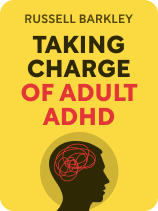

This article is an excerpt from the Shortform book guide to "Taking Charge of Adult ADHD" by Russell Barkley. Shortform has the world's best summaries and analyses of books you should be reading.
Like this article? Sign up for a free trial here.
Why are ADHD visualization techniques important? Why is it hard for people with ADHD to predict the outcomes of their actions?
Being able to see behavior patterns in your past and planning what to do about them in the future are two things that ADHD sabotages. This makes it hard to analyze the past and predict the results of your actions in the future.
Below we’ll look at some ways people with ADHD can better visualize their future.
Visualization Techniques for People With ADHD
Russell A. Barkley recommends ADHD visualization techniques that can strengthen your memory’s muscles. These range from adopting useful visual cues, exercising your different types of memory, and imagining the positive outcomes of your efforts.
(Shortform note: Though Barkley uses visualization as a tool to explore the past, motivational experts often espouse it as a way to clarify your future goals. However, in Mastery, George Leonard suggests a middle road—visualization as a tool for present-day learning. According to Leonard, visualization—or mental rehearsal—simply means creating a clear, vivid image of a skill you’re learning, such as a difficult passage on the piano. This starts the process of training your mind to form the circuits you’ll need to put your envisioned scenario into practice. The more vividly you rehearse a new habit in your mind—for instance, taking a pause before acting on your ADHD’s impulses—the stronger your “preconditioned” habits will become.)
The most difficult time to tap into memory is when you’re in the midst of challenging situations, so first let’s cover what you can do to help control your actions in advance. Barkley’s advice is to externalize your memory and use visual reminders to guide your choices. For instance, if you struggle with being on time for appointments, place a brightly colored sticky note in your line of sight to serve as a reminder. Another way to make your memory visual is to record anything you need to remember in a journal, including important dates, deadlines, and commitments you’ve made to other people. To reinforce the habit of consulting your journal, you can set an alarm on your phone or computer—another form of externalized memory.
(Shortform note: Though the visual cues Barkley recommends can help you keep track of all the things you must remember, such a system runs the risk of falling into disorganized clutter. In The Organized Mind, Daniel J. Levitin also touts the value of externalizing your memory, he says that your first step should be to sort your reminders into categories. Sorting your reminders will save your mental resources later by letting you focus on one category of tasks at a time—such as what you need to remember at work—instead of juggling competing demands from several facets of your life at once. The one risk that people with ADHD should avoid is creating so many categories that they stop being useful.)
See and Say the Past and the Future
As useful as they are, visual cues may not be helpful when you feel an immediate need to react. If you can successfully pause that reaction, Barkley offers two techniques to actively engage your visual and verbal memory.
(Shortform note: While Barkley presents visual and verbal memory as two separate systems, the relationship between them is complicated. Visual cues can intrude on verbalized thoughts, and vice versa. In The Happiness Trap, Russ Harris explains that we use words and images in our minds to create stories about who we are and what our place is in the world. However, Harris cautions against mistaking the stories your visual and verbal memory create as an accurate representation of reality. You should certainly be mindful of your thoughts and feelings, as Barkley’s advice will help you to do, but according to Harris, you should also learn to separate yourself from your thoughts so you don’t become engulfed by the negative ones.)
The first technique that Barkley recommends is to imagine holding a smartphone or a tablet and picturing yourself on its screen. Imagine pressing “play” and watching a video of some past experience similar to your current situation. Allow that video to play out long enough so that what you see on your imaginary screen can guide your responses in the present. For example, before making an impulsive purchase, watch yourself making a similar purchase in the past and follow the story to its logical end—was your prior purchase rewarding or not? That may sound like a lot to do in the brief space of time while you’re pausing, so practice this technique in low-stakes situations before expecting it to work in challenging environments.
(Shortform note: Barkley draws his visualization tools from practices in Cognitive Behavioral Therapy (CBT), which have been shown to help people work toward goals, reduce stress, and improve their problem-solving skills. However, visualizing potential situations comes with a few pitfalls. As a person with ADHD, you may find it hard to picture situations that aren’t directly in front of you. You may also find that sometimes CBT visualization brings up and reinforces negative imagery. If you find that such problems happen often, you may find it helpful to practice visualization with the aid of a mental health professional.)
If your situation will allow it, Barkley suggests that you describe and analyze your situation out loud. This activates a different part of your memory than simple visualization. The brain’s verbal processing center encodes your experience into logic, rules, and reasoning, and as a person with ADHD, you may need to train yourself to deliberately turn it on. This involves exploring questions such as: “What’s happening here? When have I been in similar situations? What did I do last time and what happened as a result?” As with visual memory processing, this may take practice to become effective, so begin with easy situations, like whether you should follow a certain recipe, before moving on to more difficult matters.
(Shortform note: Just as some of Barkley’s previous tips aim to externalize your memory, this practice externalizes your internal dialogue. In Do Hard Things, Steve Magness explains that putting your thoughts into words can help you identify the thought you want to focus on. Vocalizing thoughts gives them more power, and if your inner dialogue is convoluted, with several different thoughts jostling for attention, giving them voice can simplify any internal debate and make your thoughts more actionable.)

———End of Preview———
Like what you just read? Read the rest of the world's best book summary and analysis of Russell Barkley's "Taking Charge of Adult ADHD" at Shortform.
Here's what you'll find in our full Taking Charge of Adult ADHD summary:
- The various treatment options for ADHD in adults
- How to accept ADHD as a part of your life
- What ADHD can look like in undiagnosed adults






